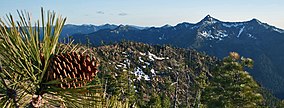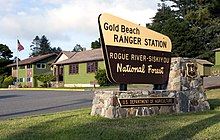Rogue River–Siskiyou National Forest: Difference between revisions
Categories |
|||
| Line 102: | Line 102: | ||
[[Category:Protected areas of Del Norte County, California]] |
[[Category:Protected areas of Del Norte County, California]] |
||
[[Category:Protected areas of Siskiyou County, California]] |
[[Category:Protected areas of Siskiyou County, California]] |
||
[[Category:Protected areas of Jackson County, Oregon]] |
|||
[[Category:Protected areas of Klamath County, Oregon]] |
|||
[[Category:Protected areas of Douglas County, Oregon]] |
|||
[[Category:Protected areas of Josephine County, Oregon]] |
|||
[[fr:Forêt nationale de Rogue River-Siskiyou]] |
[[fr:Forêt nationale de Rogue River-Siskiyou]] |
||
Revision as of 01:56, 13 February 2011
| Rogue River – Siskiyou National Forest | |
|---|---|
IUCN category VI (protected area with sustainable use of natural resources) | |
 Jeffrey pine on a high ridge | |
| Location | Oregon & California, USA |
| Nearest city | Medford, Oregon |
| Area | 1,800,000 acres (7,284 km2) |
| Established | 2004 (1906) |
| Visitors | 915,000[1] (in 2006) |
| Governing body | U.S. Forest Service |
| www | |
The Rogue River – Siskiyou National Forest is a United States National Forest located on both sides of the border between the states of Oregon and California. The formerly separate Rogue River and Siskiyou National Forests were administratively combined in 2004. Now, the Rogue River – Siskiyou National Forest ranges from the crest of the Cascade Range west into the Siskiyou Mountains, covering almost 1,800,000 acres (7,300 km2).[2] Forest headquarters are located in Medford, Oregon.
Geography

The former Rogue River portion of the Rogue River – Siskiyou National Forest is located in parts of five counties in southern Oregon and northern California. In descending order of land area they are Jackson, Klamath, Douglas, Siskiyou, and Josephine counties, with Siskiyou County being the only one in California. It has a land area of 628,443 acres (981.9 sq mi, or 2,543.2 km²). There are local ranger district offices located in Ashland, Butte Falls, Grants Pass, Jacksonville, and Prospect.

The former Siskiyou portion of the Rogue River – Siskiyou National Forest is located in parts of four counties in southwestern Oregon and northwestern California. In descending order of land area they are Curry, Josephine, and Coos counties in Oregon and Del Norte County in California. It has a land area of 1,094,726 acres (1,710.5 sq mi, or 4,430.2 km²).[3] There are local ranger district offices located in Brookings, Cave Junction, Gold Beach, and Powers.
Nearly all of the National Forest is mountainous, and includes parts of the Southern Oregon Coast Range, the Klamath Mountains, and the Cascade Range.
The largest river in the National Forest is the Rogue River, which originates in the Cascade Range and flows through the Klamath Mountains and Coast Range. The Illinois River is a major tributary of the Rogue in the Klamath Mountains, while the Sixes, Elk, Pistol, Chetco, and Winchuck rivers drain the Coast Range directly to the Pacific Ocean.
History
Siskiyou National Forest was established on October 5, 1906. On July 1, 1908 it absorbed Coquille National Forest and other lands. Rogue River National Forest traces its establishment back to the creation of the Ashland Forest Reserve on September 28, 1893 by the General Land Office. The lands were transferred to the U.S. Forest Service in 1906, and it became a National Forest on March 4, 1907. On July 1, 1908 Ashland was combined with other lands from Cascade, Klamath and Siskiyou National Forests to establish Crater National Forest. On July 18, 1915 part of Paulina National Forest was added, and on July 9, 1932 the name was changed to Rogue River.[4]
World War II bombing
On September 9, 1942, an airplane dropped bombs on Mount Emily in the Siskiyou National Forest, turned around, and flew back over the Pacific Ocean. The bombs exploded and started a fire, which was put out by several forest service employees. Bomb fragments were said to have Japanese markings. Stewart Holbrook vividly described this event in his essay "First Bomb".[5] It was later confirmed that the plane was indeed Japanese, and the incident became known as the Lookout Air Raid. It was the first bombing of the continental United States by an enemy aircraft.
Natural features

The national forest is home to some stands of old growth, including Port Orford cedar and Douglas fir in the Copper Salmon area.[6] A 1993 Forest Service study estimated that the extent of old growth in the Forest was 345,300 acres (139,700 ha)[7] some of which occurs in the Red Buttes Wilderness. Blue oak, Quercus douglasii, and Canyon live oak, Quercus chrysolepis occur in the Siskiyou National Forest. For the California endemic Blue Oak, the disjunctive stands are occurring near the northern limit of its range, which occur no farther north than Del Norte County.[8] The world's tallest pine tree is a 268.35-foot (81.79-meter) ponderosa, and is located in the national forest.[9]
In 2002 the massive Biscuit Fire burned nearly 500,000 acres (2,020 km2), including much of the Kalmiopsis Wilderness.
Protected areas
The Rogue River – Siskiyou National Forest contains all or part of eight separate designated wilderness areas, which together add up to 565,900 acres (2,290 km2)[2]:
- Copper Salmon Wilderness - 13,700 acres (55.4 km2)
- Grassy Knob Wilderness - 17,200 acres (69.6 km2)
- Kalmiopsis Wilderness - 179,775 acres (727.5 km2)
- Red Buttes Wilderness - 19,940 acres (80.7 km2)
- Rogue–Umpqua Divide Wilderness - 33,200 acres (134.4 km2)
- Siskiyou Wilderness - 152,680 acres (617.9 km2)
- Sky Lakes Wilderness - 113,590 acres (459.7 km2)
- Wild Rogue Wilderness - 35,818 acres (145.0 km2)
See also
References
- ^ Revised Visitation Estimates - National Forest Service
- ^ a b "Rogue River – Siskiyou National Forest". United States Forest Service.
- ^ Table 6 - NFS Acreage by State, Congressional District and County - United States Forest Service - September 30, 2007
- ^ Davis, Richard C. (September 29, 2005), Template:PDFlink, The Forest History Society
- ^ "First Bomb" by Stewart Holbrook, The New Yorker, October 7, 1944
- ^ Copper Salmon Wilderness Campaign - Oregon Wild
- ^ ,Bolsinger, Charles L.; Waddell, Karen L. (1993), Area of old-growth forests in California, Oregon, and Washington (PDF), United States Forest Service, Pacific Northwest Research Station, Resource Bulletin PNW-RB-197
- ^ C. Michael Hogan (2008) Blue Oak: Quercus douglasii, GlobalTwitcher.com, ed. N. Stromberg
- ^ Fattig, Paul (2011-01-23). "Tallest of the tall". Mail Tribune. Medford, Oregon. Retrieved 2011-01-27.
External links
- IUCN Category VI
- Rogue River-Siskiyou National Forest
- National Forests of California
- National Forests of Oregon
- Old growth forests
- Klamath Mountains
- Cascade Range
- Protected areas of Del Norte County, California
- Protected areas of Siskiyou County, California
- Protected areas of Jackson County, Oregon
- Protected areas of Klamath County, Oregon
- Protected areas of Douglas County, Oregon
- Protected areas of Josephine County, Oregon
